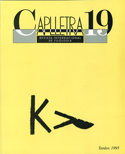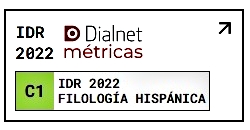Analogia i canvi morfològic: a propòsit de les formes verbals velaritzades
DOI:
https://doi.org/10.7203/caplletra.19.7376Palabras clave:
morfologia, canvi morfològic, analogia, formes verbals velaritzades Resumen
Resumen
An important series of verbs of the second conjugation exists in Catalan, characterized by a velar obstruent between the radical and the inflectional affixes. This velar segment, which in modern Catalan acts as an extension of the radical, has a heterogeneous historical origin. In short, in certain cases it stems from the strengthening of the glide of the Latin strong perfects in -UI (where w > gw > g); in others, it is justified by the maintaining of the final consonant of the radical in certain forms of the present in verbs such as dico or stringere (DICO > dic, DICAM > diga ...); in others, finally, it is due to changes of a purely analogical nature. In order to explain the latter changes, the theoretical framework of Natural Morphology has been adopted, and the analogical processes are considered to be motivated by a set of principles of morphological naturalness or optimization. To be exact, the inflectional class stability principle, the system congruity principle, the uniformity and transparency principle, and the constructional iconicity principle.
 Descargas
Descargas
Descargas
Publicado
Cómo citar
-
Resumen548
-
PDF (Català)656
Número
Sección
Licencia
El autor o autora que dirija un trabajo a la redacción de Caplletra para ser publicado tiene que ser la persona titular legítima de los derechos de explotación. La legitimación para la publicación del trabajo tiene que incluir también las imágenes, las tablas, los gráficos y otros materiales que puedan complementar el texto, con independencia de si es su autor o autora.
Copyright. Al publicar el trabajo en la revista, el autor o autora cede a Caplletra. Revista Internacional de Filologia los derechos de explotación (reproducción, distribución y comunicación pública), tanto para la edición impresa en papel como para la versión electrónica.
Todos los trabajos publicados en Caplletra se encuentran bajo una licencia Creative Commons del tipo Reconocimiento-NoComercial-SinObraDerivada 4.0.
RESPONSABILIDAD
Caplletra. Revista Internacional de Filologia no se identifica necesariamente con los puntos de vista sostenidos en los trabajos que publica.Caplletra. Revista Internacional de Filologia declina toda responsabilidad derivada de cualquier vulneración eventual de los derechos de propiedad intelectual que pudiera ser llevada a cabo por los autores o autoras.






